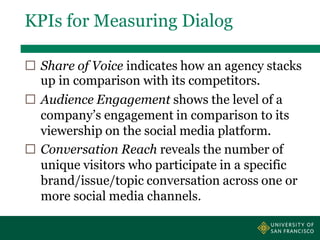Social media marketing uses social media sites to positively influence consumers toward an organization. While social media offers opportunities, some myths exist, including that it is just a fad, for young people only, or provides no return. Effective social media marketing requires understanding target audiences, goals, platforms, content strategy, and metrics. Measuring includes quantitative metrics like engagement and qualitative measures of sentiment. Tools can track key performance indicators to evaluate success.












































